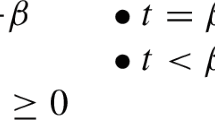Abstract
Over the past two decades a number of different approaches to “fuzzy probabilities” have been presented. The use of the same term masks fundamental differences. This paper surveys these different theories, contrasting and relating them to one another. Problems with these existing approaches are noted and a theory of “linguistic probabilities” is developed, which seeks to retain the underlying insights of existing work whilst remedying its technical defects. It is shown how the axiomatic theory of linguistic probabilities can be used to develop linguistic Bayesian networks which have a wide range of practical applications. To illustrate this a detailed and realistic example in the domain of forensic statistics is presented.
Similar content being viewed by others
References
Aitken C, Taroni F, Garbolino P (2003) A graphical model for the evaluation of cross-transfer evidence in DNA profiles. Theo Popul Biol 63(3): 179–190
Balding DJ, Donnelly P (1995) Inference in forensic identification. J R Stat Soc Ser A 158: 21–53
Budescu DV, Wallsten TS (1985) Consistency in interpretation of probabilistic phrases. Organ Behav Hum Decis Process 36: 391–405
Cook R, Evett I, Jackson G, Jones P, Lambert J (1998) A hierarchy of propositions: deciding which level to address in casework. Sci Justice 38: 231–239
Cook R, Evett I, Jackson G, Jones P, Lambert J (1998) A model for case assessment and interpretation. Sci Justice 38: 151–156
Cook R, Evett I, Jackson G, Jones P, Lambert J (1999) Case pre- assessment and review in a two-way transfer case. Sci Justice 39: 103–111
Dawid AP, Mortera J, Pascali VL, van Boxel DW (2002) Probabilistic expert systems for forensic inference from genetic markers. Scand J Stat 29: 577–595
de Cooman G (2005) A behavioural model for vague probability assessments. Fuzzy Sets Syst 154(3): 305–358
Evett I, Jackson G, Lambert J (2000a) More on the hierarchy of propositions: exploring the distinction between explanations and propositions. Sci Justice 40: 3–10
Evett I, Jackson G, Lambert J, McCrossan S (2000b) The impact of the principles of evidence interpretation on the structure and content of statements. Sci Justice 40: 233–239
Gómez Marin-Blazquez J, Shen Q (2002) From approximative to descriptive fuzzy classifiers. IEEE Trans Fuzzy Syst 10(4): 487–497
Grimmet G, Welsh D (1986) Probability: an introduction. Oxford University Press, Oxford
Halliwell J, Keppens J, Shen Q (2003) Linguistic bayesian networks for reasoning with subjective probabilities in forensic statistics. In: Proceedings of the 9th international conference on AI and law. ACM, pp 42–50
Halliwell J, Shen Q (2002) Towards linguistic probability theory. In: Proceedings of the 11th international conference on fuzzy systems, pp 596–601
Jain P, Agogino AM (1990) Stochastic sensitivity analysis using fuzzy influence diagrams. In: Schachter RD, Levitt TS, Kanal LN, Lemmer JF(eds) Uncertainty in artificial intelligence, vol 4. North-Holland, Amsterdam, pp 79–92
Kahneman D, Slovic P, Tversy A (1985) Judgement under uncertainty: heuristics and biases. Cambridge University Press, Cambridge
National Research Council Governing Board Commitee on the Assessment of Risk (1981) The handling of risk assessments in NRC reports, Washington DC
Okuda T, Tanaka H, Asai K (1978) A formulation of fuzzy decision problems with fuzzy information, using probability measures of fuzzy events. Inf Control 38: 135–147
Pearl J (1988) Probabilistic reasoning in intelligent systems. Morgan Kaufmann, San Mateo
Russell B (1923) Vagueness. Australas J Psychol Philos 1: 84–92
Tanaka H, Okuda T, Asai K (1979) Fuzzy information and decision in statistical model. In: Gupta M, Rage P, Yager R(eds) Advances in fuzzy sets theory and applications. North Holland, Amsterdam, pp 303–320
Wallsten TS, Budescu DV, Rapoport A, Zwick R, Forsyth B (1986) Measuring the vague meanings of probability terms. J Exp Psychol Gen 115(4): 348–365
Zadeh L (1975) The concept of a linguistic variable and its application to approximate reasoning. Part 2. Inf Sci 8: 301–353
Zadeh L (1984) Fuzzy probabilities. Inf Process Manag 20: 363–372
Zadeh L (1996) Fuzzy logic = computing with words. IEEE Trans Fuzzy Syst 2: 103–111
Zimmer AC (1983) Verbal vs. numerical processing of subjective probabilities. In: Scholz RW(eds) Decision making under uncertainty. North-Holland, Amsterdam
Zimmer AC (1986) What uncertainty judgements can tell about the underlying subjective probabilities. In: Kanal LN, Lemmer JF(eds) Uncertainty in artificial intelligence. North-Holland, Amsterdam
Author information
Authors and Affiliations
Corresponding author
Rights and permissions
About this article
Cite this article
Halliwell, J., Shen, Q. Linguistic probabilities: theory and application. Soft Comput 13, 169–183 (2009). https://doi.org/10.1007/s00500-008-0304-1
Published:
Issue Date:
DOI: https://doi.org/10.1007/s00500-008-0304-1




